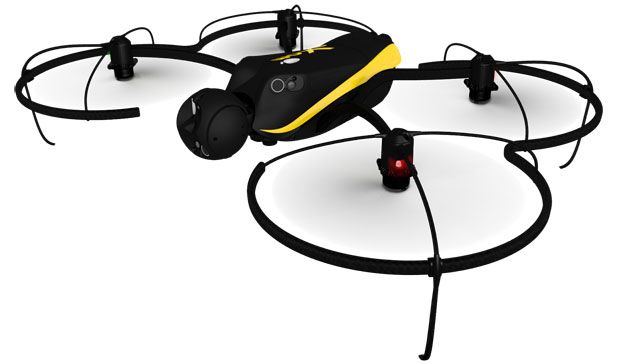Since Parrot acquired senseFly back in 2012, we’ve been looking forward to seeing what the EPFL-LIS spinoff would come up with next. If you were paying close attention a few weeks ago, you noticed a little teaser for a new drone called eXom. It looked awesome. Turns out, it is awesome, and here are details.
First, let’s have a look at the eXom drone in (admittedly quite limited) action:
Several things are being demonstrated here:
In this clip eXom is flying 100% autonomously, without being remotely controlled and without the use of GPS. It is using its onboard vision and ultrasonic proximity sensors to stabilise, hold and correct its position, while the artificial intelligence built into its autopilot enables it to execute pre-programmed movements in sync with the music.
So the demo is of the fact that the drone can “dance” around while maintaining its position in the air, without the aid of external tracking or GPS. This is where you can see some of Parrot’s influence, because this software and sensor-driven inherently stable behavior is one of the things that makes the AR Drone so easy to fly.
The eXom drone is fusing inputs from multiple sensors for position holding, but just like the AR Drone, it’s depending primarily on two: downward-facing sonar to maintain altitude, and a downward-facing camera that’s doing optic flow tracking on ground features to maintain x/y position. This, incidentally, is likely why the surface underneath the drone has that tile pattern: more unique features means better tracking, and it’s possible (even probable) that the drone would drift a bit above a featureless surface like solid carpeting.
While Parrot’s drones (including the new Bebop) have just one of these modules that fuse vision and ultrasonic sensing, eXom has five, for optimal coverage in 360 degrees, not just downward: sensor module locations include left side, right side, underbelly, rear, and built inside its forward/upward facing camera head.

SenseFly had two goals with eXom. The first was to “create an autonomous quadcopter that is highly stable in the air,” and the second was to “produce the safest system on the market by giving the user full situational awareness.” With the comprehensive coverage from these vision and ultrasonic sensors, eXom can detect obstacles just about anywhere around it.
The company says that the user will have several options on how to leverage this with different flight modes of various levels of autonomy:
- Interactive ScreenFly mode – click or tap the on-screen video feed to define an object of interest. eXom’s intelligent autopilot moves the drone into position and directs its TripleView head automatically.
- Autonomous mode – define the area to map using the drone’s eMotion software. The software automatically generates the drone’s flight plan, then eXom takes off, flies, acquires imagery and lands itself (similar to senseFly’s fixed-wing eBee drones).
These capabilities are very cool, especially if they can compensate for bad piloting when in manual mode. Some drones can do this with GPS to a limited extent (like, you set up a safety box of GPS points somewhere in midair), but I’d absolutely love a drone that could use onboard sensors to prevent me (one of those aforementioned bad pilots) from running into any obstacles or the ground. And also, you know, the whole delivery drones thing: any reliably safe urban delivery drone would probably need a sensor package a lot like this.
Now, let’s talk about that crazy looking camera head. While Parrot’s Bebop drone relies on software to provide active stabilization while simulating a pan/tilt camera, eXom does it the old-fashioned (if you want to call it that) way, with a camera system that is hardware stabilized and can physically move to look around. The camera head itself has a 270 degree vertical field of view, meaning that it can look both straight up and straight down and even slightly behind.
In terms of actual cameras, you’ve got two: a HD video camera that can also capture ultra-high resolution still images, and a thermal camera. You can record all of these data at once, meaning no landings to switch sensors. With a drone that can safely get very close to objects and take high resolution images of them, we’re probably looking at a drone that’s optimized for civil infrastructure inspection.
In other words, this drone is more like a tool than a toy, and as such it will not be an inexpensive piece of hardware. Were we to guess wildly, we’d put the cost of eXom somewhere in the very low five figures, partially because as with senseFly’s other drones, you’re not just paying for the hardware, you’re also paying for the spectacular control software and the reliable out-of-the-box workingness. And from the look of things, it’ll be worth every penny.
[ senseFly eXom ]









